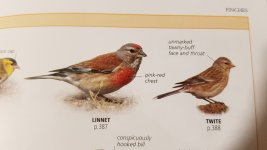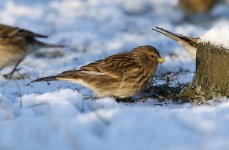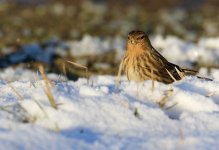
Would be quite rare now in the region, so just in case.
Brownish finch, roughly the size of Siskin (Siskins were perched on a nearby conifer), relatively dense black streaking on breast and flanks with rectangular area on belly left unstreaked, no yellowish tones whatsoever on underparts, yellowish supercilium above darker eye stripe, crown somewhat darker brown than underparts, no red poll seen, double buff wingbar, not confident about the beak colour, but when the sun shone through it (twice), it was clearly yellow. I saw a paler area (rather greyish than rosy) at the rump, but I thought I was seeing things, until I read about this feature of Twite (my ID is based mostly on the yellow beak when backlit, the double wingbar and this). No photos, as I had no camera, only a smartphone, and taking photos against the background of someone's window while leaning against the fence would be a bit awkward anyway. I hope to return there later, so no ID is fine by me.
Other (reasonably common) candidates include Common Linnet and Common Redpoll. My assumption is a female/immature Twite. There was also a second bird nearby, but I lost sight of it. Thanks in advance!
EDIT: today, Warsaw area, in someone's garden (in a town with big gardens and scattered housing; a lake, forest and marshy tract nearby; fields some way off); relative beak size is one thing I failed to note; the bird appeared somewhat fluffed up, but maybe it depends on other factors as well
Brownish finch, roughly the size of Siskin (Siskins were perched on a nearby conifer), relatively dense black streaking on breast and flanks with rectangular area on belly left unstreaked, no yellowish tones whatsoever on underparts, yellowish supercilium above darker eye stripe, crown somewhat darker brown than underparts, no red poll seen, double buff wingbar, not confident about the beak colour, but when the sun shone through it (twice), it was clearly yellow. I saw a paler area (rather greyish than rosy) at the rump, but I thought I was seeing things, until I read about this feature of Twite (my ID is based mostly on the yellow beak when backlit, the double wingbar and this). No photos, as I had no camera, only a smartphone, and taking photos against the background of someone's window while leaning against the fence would be a bit awkward anyway. I hope to return there later, so no ID is fine by me.
Other (reasonably common) candidates include Common Linnet and Common Redpoll. My assumption is a female/immature Twite. There was also a second bird nearby, but I lost sight of it. Thanks in advance!
EDIT: today, Warsaw area, in someone's garden (in a town with big gardens and scattered housing; a lake, forest and marshy tract nearby; fields some way off); relative beak size is one thing I failed to note; the bird appeared somewhat fluffed up, but maybe it depends on other factors as well
Last edited:









